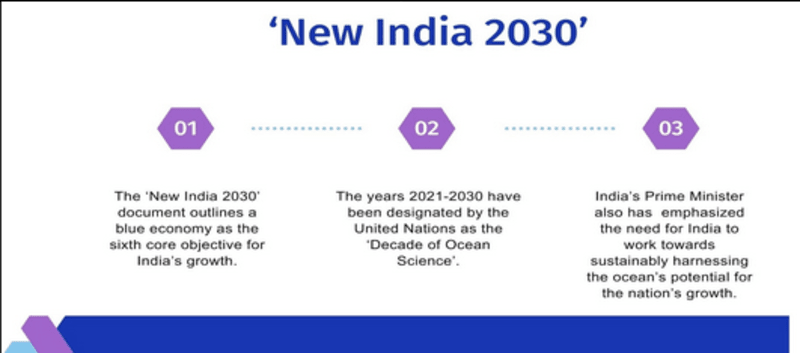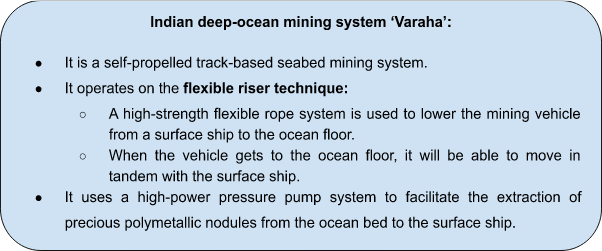Relevance: GS Paper - III
News Excerpt:
To examine biodiversity and explore deep-sea resources, India's first manned Deep Ocean Mission, called "Samudrayaan", intends to send three people in a submersible down to a depth of six kilometers (6000m) in the ocean.
About DOM:
-
It is India’s ambitious program, chiefly implemented by the Ministry of Earth Sciences (MoES).
-
It is one of nine tasks implemented under the Prime Minister's Science, Technology, and Innovation Advisory Council (PMSTIAC).
-
Supporting blue trade, blue manufacturing in India, and the blue economy priority area are critical priorities for DOM.
-
It was approved by the Union Cabinet in 2021 at a cost of nearly Rs 4,077 crore over five years in a phased manner.
Six pillars of the mission:
-
Development of technologies:
-
Creation of deep-sea mining technology and a manned submersible that can descend to 6,000 meters below the ocean's surface with three people on board.
-
Various research instruments, sensors, and an integrated system for extracting polymetallic nodules from the central Indian Ocean.
-
-
Ocean Climate Change advisory services:
-
Building advisory services for ocean climate change that use a variety of ocean measurements and models to comprehend and forecast future climate.
-
-
Technological innovations:
-
Focus on technological advancements for the study and preservation of biodiversity in the deep sea.
-
-
Identify potential sites of multi-metal hydrothermal sulfide mineralization:
-
Determination of potential areas for multi-metal hydrothermal sulfide mineralization throughout the mid-oceanic ridges of the Indian Ocean by deep-ocean survey and exploration.
-
-
Harnessing energy and freshwater from the ocean:
-
Exploration and development of devices to capture energy from oceanic sources, including thermal, wave, and tidal energy.
-
-
Advanced Marine Station for Ocean Biology:
-
Establishing a cutting-edge Marine Station for Ocean Biology as a center for developing talent and advancing new directions in blue biotechnology and ocean biology.
-

Why has a depth of 6,000 m been chosen?
-
India has committed to the sustainable exploitation of precious minerals, such as polymetallic sulfides and nodules.
-
For this reason, ISA (International Seabed Authority) has given India 10,000 sq. km. at 26° S and a 75,000-sq.-km. area in the middle Indian Ocean.
-
Polymetallic sulfides occur at around 3,000 m in the central Indian Ocean, while polymetallic nodules, which contain precious metals including copper, manganese, nickel, iron, and cobalt, are found at a depth of about 5,000 m.
-
Therefore, our interests span depths of 3,000-5,500 m. By equipping ourselves to operate at a depth of 6,000 m, we can effectively cater to both the Indian Exclusive Economic Zone and the central Indian Ocean.
Estimated Ocean Resources for India:
-
Preliminary estimates indicate that the area allocated to us has 380 Million Metric Tonnes (MMT) of Polymetallic Nodules (PMN).
-
It comprises Copper, Nickel, Cobalt, and Manganese which are available within an allocated area of 75000 sq. km for exploration of PMN in the Central Indian Ocean Basin.
-
The estimated value of these metals is about 110 billion US$. The polymetallic sulfides are expected to contain rare earth minerals including gold and silver.
Challenges associated with the exploration of the deep oceans:
-
High Pressure:
-
An object of one square meter area below 1 meter underwater experiences a weight of around 10,000 kg, which is equivalent to a huge adult elephant.
-
Requirement of meticulously designed equipment:
-
Working in such high-pressure situations calls for the usage of carefully planned machinery made of durable metals or materials.
-
Inadequately built equipment implodes or collapses inside the water.
-
Incredibly soft and muddy surface at sea-bed:
-
This factor renders it exceedingly difficult for heavy vehicles to land or maneuver, as they would inevitably sink.
-
Extraction of minerals:
-
The process of extracting resources necessitates pumping them to the surface, which is a power- and energy-intensive operation.
-
Because there is no electromagnetic wave transmission in the deep water, remotely operated vehicles are useless there.
-
Another major obstacle is visibility since natural light can only reach a few tens of meters below the surface.
-
Others factors:
-
Variations in temperature, corrosion, salinity, etc., all of which compound the problems.
Significance of MATSYA-6000 on the global front:
-
It aims to reach the ocean bed at a depth of 6,000 m.
-
The submersible, which is driven by three crew members known as "aquanauts," is equipped with a variety of scientific instruments and apparatuses
-
That will make it easier to conduct experiments, gather samples, make basic audio and video recordings, and make observations.
-
Japan, France, China, Russia, and the United States have all completed successful deep-ocean crewed missions before.
-
India is prepared to become one of these countries by showcasing its proficiency and ability to conduct crewed deep-ocean missions.
-
It seamlessly combines the best and most feasible features of remote-operated vehicles (ROVs) and autonomous remote vehicles (AUVs).
-
Three people can travel within the 2.1-meter diameter specialized sphere that makes up the interior of Matsya-6000.
-
The human sphere would be roughly 28 tonnes in weight and have a short-sleeved, life-supporting environment that removes carbon dioxide and supplies oxygen.
-
The sphere is made of titanium alloy and designed to sustain pressures as high as 6,000 bar.
-
It has three viewports that let the crew see its surroundings in real-time, and it has propellers that allow it to move in all six directions.
-
Communication will be achieved through sound – an acoustic phone and modem.
-
Importantly, it will not be actively lowered through sinking; instead, it will function as a free-floating system, for energy efficiency.
-
It can move at a speed of about 5.5 km/hr using underwater thrusters, which is adequate.
-
With Matsya, India will have the sole entire ecosystem of underwater vehicles, including deep-water ROVs, polar ROVs, AUVs, and deep-water coring systems.
Environmental impact of DOM:
-
As per the International Union for Conservation of Nature (IUCN), various organisms reside here in harsh environments like low oxygen and sunshine levels, high pressure, and extremely cold temperatures.
-
Even before they are discovered by science, these mining missions have the potential to wipe them off.
-
The biodiversity and ecology of the deep water are still poorly understood, which makes it challenging to evaluate the effects on the ecosystem.
-
As per Environmentalists, sediment plumes will be generated as the suspended particles can rise to the surface harming the filter feeders in the upper ocean layers.
-
There are also concerns regarding the noise and light pollution from the mining vehicles and oil spills from the operating vessels.
Additional information:

